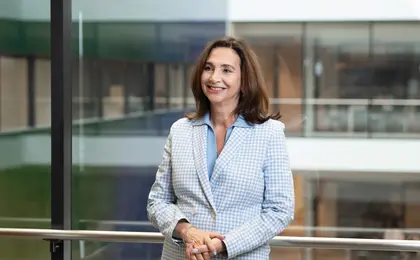
Adam Goldfarb ’05
MBA
Senior Fellow, Shared Prosperity, Schmidt Futures
Adam Goldfarb ’05 describes the stages of his career as a series of “moments.”
There was the Obama moment, when he left Yale Law School for a semester to work on the then-senator’s presidential campaign. The Cory Booker moment, during which Goldfarb served as a senior policy advisor on economic development for the future senator while he served as mayor of Newark. And there was the education reform moment, when Goldfarb—after helping found People’s Prep Charter School in Newark—followed Yale Law alum Stefan Pryor, Booker’s former deputy mayor, to the Connecticut State Department of Education, where he worked to pass major legislation aimed at raising academic outcomes for all students.
“I just found what those people were doing to be extremely captivating,” Goldfarb recalls. “I felt like that was what I had been training for—to find a moment of opportunity where really entrepreneurial leaders were creating the political space to do more.”
Goldfarb says he felt prepared to work in the public sector in part because of the years he spent at Yale SOM, where he enrolled through the Silver Scholars Program immediately after finishing his bachelor’s degree in ethics, politics, and economics at Yale University in 2002.
“Entering government—as I ended up doing—with a set of skills from an MBA degree probably added a bit of credibility to my ability to contribute,” he explains.
Goldfarb has long been interested in public policy. He served on his local school board as a high school student in Princeton, New Jersey, and says “issues of justice were at the forefront of dinner conversations” in his family.
At Yale, an undergraduate course on New Haven taught by Professor Emeritus Douglas W. Rae first sparked Goldfarb’s interest in an MBA.
“I was very gripped by the narrative of American cities and their prospects for rebirth through a different set of technical strategies,” he explains. “My concept was using the MBA for social change, which I have in common with a lot of SOMers.”
In the Silver Scholars Program, students complete their first year at SOM, spend their second year working full time, and then return to SOM for their final year of classes. Goldfarb’s internships took him to the Lower Manhattan Development Corporation, where he worked on rebuilding after the September 11 terrorist attacks. He also worked for an affordable housing developer, helping the company structure tax credit-funded projects.
On campus, Goldfarb says courses with Barry Nalebuff and Rae were among his favorites, as was a class on nonprofit strategy with late Professor Emeritus Sharon M. Oster.
After graduating from SOM, Goldfarb went straight to Yale Law School, where he deferred his graduation for a semester to work for the Obama campaign as an intern in the Chicago headquarters and a field organizer in New Jersey. He was not alone in his political enthusiasm; his roommate at the time worked for Hillary Clinton’s campaign.
“It was almost like a dropout disease swept the class,” Goldfarb recalls. “It was the 2008 primaries, and there was this burst of excitement: Someone dropped out and went to Iowa. Someone else went to New Hampshire. It was too good an opportunity to pass up.”
In 2015, after working for Booker and the State of Connecticut for several years, Goldfarb moved to New York, where he consulted on education-related projects with clients such as Bloomberg Philanthropies and the Association of College and University Educators.
Toward the end of his time as a consultant, and in part through his experience with the charter school he helped found, he became interested in workforce development—namely, job training efforts that could bridge the gap between formal education and careers.
Even when low-income students do well in high school, he says, “college retention and completion was still too high a hill. I am one of many K-12 people whose interests have migrated to a later age.”
In 2021, after doing some work for Schmidt Futures, the philanthropy formed by former Google CEO Eric Schmidt and his wife, Wendy Schmidt, Goldfarb joined the organization as a senior fellow working on economic empowerment. Today, his job is to help catalyze moments for change like the ones he was able to participate in as a student and young professional.
Goldfarb’s team looks for groups that are finding new ways to train low-income, racially diverse learners, and to place them into upwardly mobile careers.
“We’re very interested in how we can help that space grow faster,” he says.
In government and now philanthropy, Goldfarb says he has appreciated the opportunity to make change at the “system level,” describing the experience as “intellectually exciting.”
But he also says the work requires a certain level of humility.
“You’re in the position to be able to say, ‘We think capital should flow in this direction and maybe not that one,’” he explains. “You need to be really humble and mindful of that privilege.”
Throughout his career, Goldfarb says he has continued to rely on—and find inspiration in—the SOM community.
“Certain times, I’ll meet someone in the world of impact, and they turn out to be an SOM person,” he says. “There’s something the school is pulling off pretty well about finding people who want to make an impact and giving them the skills to do that.”





